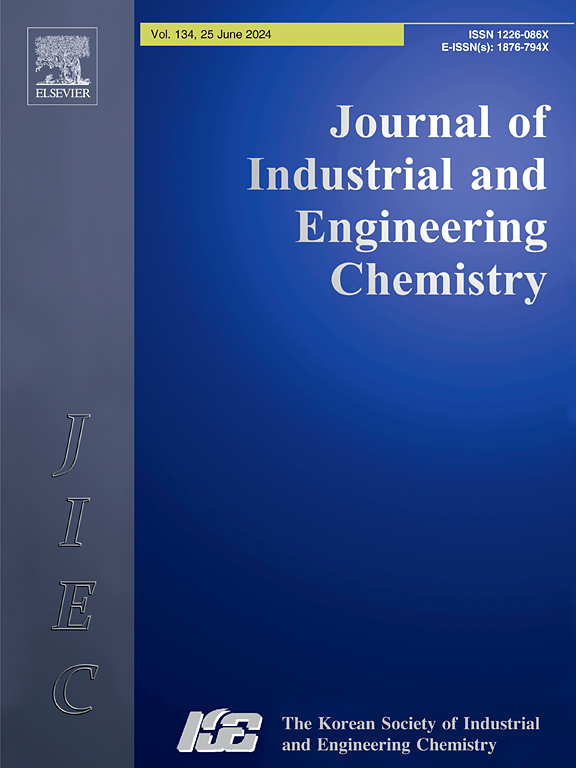Self-assembled anticancer drug-loaded nanoparticles of hyaluronic acid conjugated with ursolic acid for enhanced combination chemotherapy
IF 5.9
3区 工程技术
Q1 CHEMISTRY, MULTIDISCIPLINARY
Journal of Industrial and Engineering Chemistry
Pub Date : 2024-11-30
DOI:10.1016/j.jiec.2024.11.056
引用次数: 0
Abstract
We propose hyaluronic acid (HA)-based nanoparticles for cancer-specific combination therapy, delivering ursolic acid (UA) and the anticancer drug doxorubicin (DOX). HA was conjugated with UA via disulfide bonds (i.e., HA-ss-UA), enabling self-assembly into nanoparticles with a hydrophobic UA core and thereby, effective encapsulation of hydrophobic DOX. The nanoparticles facilitated internalization into cancer cells due to interactions between HA and CD44 receptors. In a cancer-specific, glutathione-rich environment, the disulfide bonds in the nanoparticles were cleaved effectively, releasing more than 90% of the conjugated UA and DOX sustainably for 2 days. In vitro testing with A549 cancer cells showed enhanced endocytosis and anticancer efficacy of the nanoparticles. Intratumoral delivery of the nanoparticles to A549-bearing mice demonstrated the most potent anticancer effect compared to other delivery formulations. Therefore, the anticancer drug-loaded nanoparticles, composed of HA conjugated with UA via disulfide bonds, represent a promising formulation for cancer-specific combination therapy.

透明质酸与熊果酸偶联的自组装抗癌载药纳米颗粒增强联合化疗
我们提出基于透明质酸(HA)的纳米颗粒用于癌症特异性联合治疗,递送熊果酸(UA)和抗癌药物阿霉素(DOX)。HA通过二硫键与UA偶联(即HA-ss-UA),能够自组装成具有疏水UA核心的纳米颗粒,从而有效地封装疏水DOX。由于HA和CD44受体之间的相互作用,纳米颗粒促进了癌细胞的内化。在癌症特异性的富含谷胱甘肽的环境中,纳米颗粒中的二硫键被有效地切割,持续释放超过90%的共轭UA和DOX 2天。体外A549癌细胞实验表明,纳米颗粒增强了癌细胞的内吞作用和抗癌作用。与其他递送配方相比,肿瘤内递送纳米颗粒给携带a549的小鼠显示出最有效的抗癌效果。因此,由HA和UA通过二硫键偶联而成的抗癌药物负载纳米颗粒代表了一种有前景的癌症特异性联合治疗配方。
本文章由计算机程序翻译,如有差异,请以英文原文为准。
求助全文
约1分钟内获得全文
求助全文
来源期刊
CiteScore
10.40
自引率
6.60%
发文量
639
审稿时长
29 days
期刊介绍:
Journal of Industrial and Engineering Chemistry is published monthly in English by the Korean Society of Industrial and Engineering Chemistry. JIEC brings together multidisciplinary interests in one journal and is to disseminate information on all aspects of research and development in industrial and engineering chemistry. Contributions in the form of research articles, short communications, notes and reviews are considered for publication. The editors welcome original contributions that have not been and are not to be published elsewhere. Instruction to authors and a manuscript submissions form are printed at the end of each issue. Bulk reprints of individual articles can be ordered. This publication is partially supported by Korea Research Foundation and the Korean Federation of Science and Technology Societies.

 求助内容:
求助内容: 应助结果提醒方式:
应助结果提醒方式:


